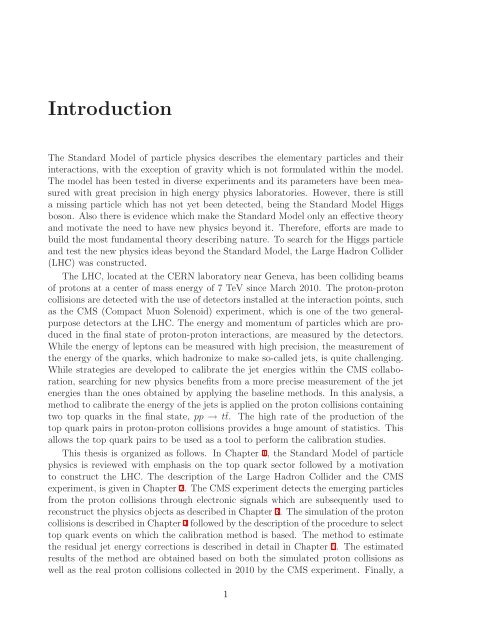Measurement of the Jet Energy Scale in the CMS experiment ... - IIHE
Measurement of the Jet Energy Scale in the CMS experiment ... - IIHE
Measurement of the Jet Energy Scale in the CMS experiment ... - IIHE
You also want an ePaper? Increase the reach of your titles
YUMPU automatically turns print PDFs into web optimized ePapers that Google loves.
IntroductionThe Standard Model <strong>of</strong> particle physics describes <strong>the</strong> elementary particles and <strong>the</strong>ir<strong>in</strong>teractions, with <strong>the</strong> exception <strong>of</strong> gravity which is not formulated with<strong>in</strong> <strong>the</strong> model.The model has been tested <strong>in</strong> diverse <strong>experiment</strong>s and its parameters have been measuredwith great precision <strong>in</strong> high energy physics laboratories. However, <strong>the</strong>re is stilla miss<strong>in</strong>g particle which has not yet been detected, be<strong>in</strong>g <strong>the</strong> Standard Model Higgsboson. Also <strong>the</strong>re is evidence which make <strong>the</strong> Standard Model only an effective <strong>the</strong>oryand motivate <strong>the</strong> need to have new physics beyond it. Therefore, efforts are made tobuild <strong>the</strong> most fundamental <strong>the</strong>ory describ<strong>in</strong>g nature. To search for <strong>the</strong> Higgs particleand test <strong>the</strong> new physics ideas beyond <strong>the</strong> Standard Model, <strong>the</strong> Large Hadron Collider(LHC) was constructed.The LHC, located at <strong>the</strong> CERN laboratory near Geneva, has been collid<strong>in</strong>g beams<strong>of</strong> protons at a center <strong>of</strong> mass energy <strong>of</strong> 7 TeV s<strong>in</strong>ce March 2010. The proton-protoncollisions are detected with <strong>the</strong> use <strong>of</strong> detectors <strong>in</strong>stalled at <strong>the</strong> <strong>in</strong>teraction po<strong>in</strong>ts, suchas <strong>the</strong> <strong>CMS</strong> (Compact Muon Solenoid) <strong>experiment</strong>, which is one <strong>of</strong> <strong>the</strong> two generalpurposedetectors at <strong>the</strong> LHC. The energy and momentum <strong>of</strong> particles which are produced<strong>in</strong> <strong>the</strong> f<strong>in</strong>al state <strong>of</strong> proton-proton <strong>in</strong>teractions, are measured by <strong>the</strong> detectors.While <strong>the</strong> energy <strong>of</strong> leptons can be measured with high precision, <strong>the</strong> measurement <strong>of</strong><strong>the</strong> energy <strong>of</strong> <strong>the</strong> quarks, which hadronize to make so-called jets, is quite challeng<strong>in</strong>g.While strategies are developed to calibrate <strong>the</strong> jet energies with<strong>in</strong> <strong>the</strong> <strong>CMS</strong> collaboration,search<strong>in</strong>g for new physics benefits from a more precise measurement <strong>of</strong> <strong>the</strong> jetenergies than <strong>the</strong> ones obta<strong>in</strong>ed by apply<strong>in</strong>g <strong>the</strong> basel<strong>in</strong>e methods. In this analysis, amethod to calibrate <strong>the</strong> energy <strong>of</strong> <strong>the</strong> jets is applied on <strong>the</strong> proton collisions conta<strong>in</strong><strong>in</strong>gtwo top quarks <strong>in</strong> <strong>the</strong> f<strong>in</strong>al state, pp → t¯t. The high rate <strong>of</strong> <strong>the</strong> production <strong>of</strong> <strong>the</strong>top quark pairs <strong>in</strong> proton-proton collisions provides a huge amount <strong>of</strong> statistics. Thisallows <strong>the</strong> top quark pairs to be used as a tool to perform <strong>the</strong> calibration studies.This <strong>the</strong>sis is organized as follows. In Chapter 1, <strong>the</strong> Standard Model <strong>of</strong> particlephysics is reviewed with emphasis on <strong>the</strong> top quark sector followed by a motivationto construct <strong>the</strong> LHC. The description <strong>of</strong> <strong>the</strong> Large Hadron Collider and <strong>the</strong> <strong>CMS</strong><strong>experiment</strong>, is given <strong>in</strong> Chapter 2. The <strong>CMS</strong> <strong>experiment</strong> detects <strong>the</strong> emerg<strong>in</strong>g particlesfrom <strong>the</strong> proton collisions through electronic signals which are subsequently used toreconstruct <strong>the</strong> physics objects as described <strong>in</strong> Chapter 3. The simulation <strong>of</strong> <strong>the</strong> protoncollisions is described <strong>in</strong> Chapter 4 followed by <strong>the</strong> description <strong>of</strong> <strong>the</strong> procedure to selecttop quark events on which <strong>the</strong> calibration method is based. The method to estimate<strong>the</strong> residual jet energy corrections is described <strong>in</strong> detail <strong>in</strong> Chapter 5. The estimatedresults <strong>of</strong> <strong>the</strong> method are obta<strong>in</strong>ed based on both <strong>the</strong> simulated proton collisions aswell as <strong>the</strong> real proton collisions collected <strong>in</strong> 2010 by <strong>the</strong> <strong>CMS</strong> <strong>experiment</strong>. F<strong>in</strong>ally, a1
















